Explore the latest insights from top science journals in the Muser Press daily roundup (July 28, 2025), featuring impactful research on climate change challenges.
In brief:
Decoding the blue: Advanced Technology realizes potential in harmful algal bloom monitoring
Researchers at the University of Birmingham have developed a powerful new method to detect harmful blue-green algae in freshwater lakes. Their method, which involves advanced mass spectrometry technology, can identify toxin producing blue-green algae before they become damaging in recreational waters and pose threat to public health.
Blue-green algae (scientifically named as cyanobacteria) are micro-organisms commonly found in ponds, lakes, and oceans worldwide. In optimum growth conditions, they can form huge “blooms” that appear like green slime covering the surface of the water.
Although these blooms are extremely effective at carbon capture and oxygen production, certain varieties produce toxins that are harmful for aquatic life, animals and humans.
Published in the Journal of The American Chemical Society, the groundbreaking study analysed samples from lakes across the UK and found that lakes differ in their blue-green algae content.
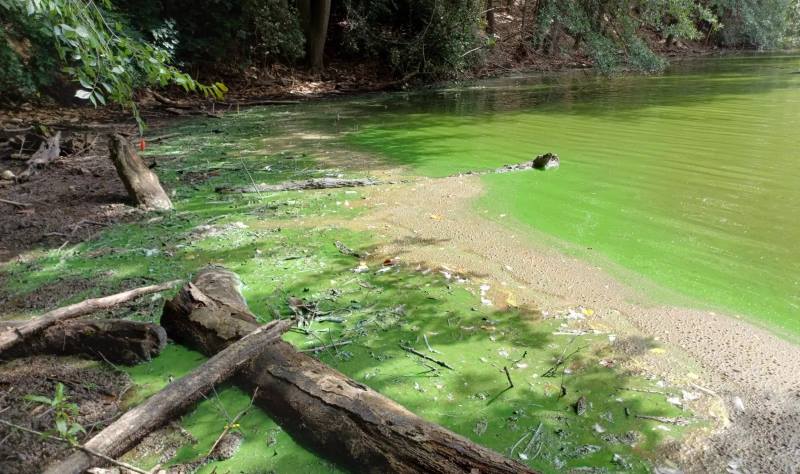
Unlike traditional methods such as microscopy or genetic sequencing, the new approach focussed on the blue component of the blue-green algae. The researchers from the School of Biosciences and the School of Chemical Engineering noticed that blue-green algae’s blue component differed subtly in size between different cyanobacterial species. This enabled them to discriminate between blue-green algae that produces toxins and those that do not.
Jaspreet Sound, PhD researcher at the University of Birmingham and first author of the paper commented: “Our approach is quick and really sensitive, so can be used to monitor how all the cyanobacteria are competing for growth within lake water prior to the domination of a single toxic strain emerging.”
The technique can also simultaneously detect the presence of the toxins, known as cyanotoxins, which are known to cause liver damage and neurological effects in humans and animals.
Dr Tim Overton, Reader in Microbial Biotechnology at the School of Chemical Engineering at the University of Birmingham, commented: “The new technique advances existing approaches and will not only help improve water quality for human use but also plays a role in understanding how to protect critical wetland environments.”
Dr Aneika Leney, Associate Professor of Biological Mass Spectrometry at the University of Birmingham and senior author of the study commented: “As climate change increases, so will the variability and complexity of bloom dynamics, so the ability to identify bloom composition and toxin presence will help us make data-driven decisions about water use restrictions, treatment, and public health advisories.”
The technology impacts several UN Sustainable Development Goals, such as Clean Water and Sanitation and Good Health and Wellbeing, which aim to improve human lives and protect the environment by tackling the effects of climate change.
Lakes frequently have toxin levels exceeded World Health Organization (WHO) guidelines for drinking water, highlighting the urgent need for early detection tools to protect both the public and local ecosystems. The team believe their mass spectrometry technique could play a vital role in protecting water quality and public health in the coming years.
Journal Reference:
Jaspreet K. Sound, Hannah E. Wedgwood, Qonita Afinanisa, Tim W. Overton, and Aneika C. Leney, ‘A Protein-Centric Mass Spectrometry Approach for Species Identification within Harmful Algal Blooms’, Journal of the American Chemical Society (2025). DOI: 10.1021/jacs.5c07419
Article Source:
Press Release/Material by University of Birmingham
Central American countries most affected by plastic bottle pollution
Most of the plastic bottles and caps that pollute the Pacific coasts of Latin American countries are of local origin, and are mainly produced by the multinational companies The Coca-Cola Company, Aje Group and PepsiCo. The countries most affected by these pollutants are those in Central America, probably due to high consumption of beverages in plastic containers, poor waste management and transport by ocean currents. On the island coasts, bottles of Asian origin are more abundant, probably dumped from ships and transported by currents.
These are some revealing findings of the first regional study to track plastic bottles (and caps) on beaches and coastal cities in 10 Latin American countries. Along more than 12,000 kilometres of Pacific coastline from Mexico to Chile – including islands such as Rapa Nui (Easter Island), the Galápagos and Robinson Crusoe – the study sampled a total of 92 mainland beaches, 15 island beaches and 38 human settlements.
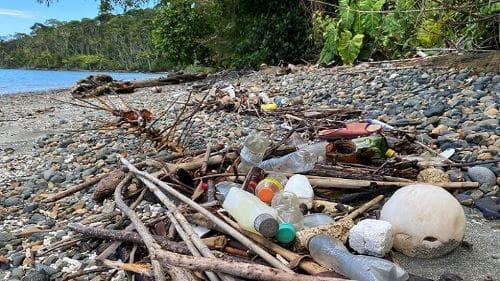
The paper, published in the Journal of Cleaner Production, involves researchers Miquel Canals and Ostin Garcés-Ordóñez, from the Consolidated Research Group in Marine Geosciences of the Faculty of Earth Sciences of the University of Barcelona, who are also director and member, respectively, of the UB Chair on Sustainable Blue Economy, sponsored by the environmental consultancy Tecnoambiente.
The study, which covered Mexico, Guatemala, El Salvador, Nicaragua, Costa Rica, Panama, Colombia, Ecuador, Peru and Chile, relied heavily on citizen science, thanks to the involvement and collaboration of 1,000 volunteers and 200 local leaders from 74 social organizations.
Faced with the problem of plastic pollution, the study warns of the urgent need to strengthen local waste management and to implement regional actions to reduce the environmental impact of these products. Given that the most consumed products are single-serve and single-use bottles, it is recommended that the production of returnable and reusable packaging be encouraged by the companies that produce them.
Bottles carrying information
Plastic pollution is a problem that affects the entire planet. On the coasts, plastic bottles and caps are a major component of accumulated litter and it is therefore essential to identify where they come from in order to improve the management of this type of waste and prevent its environmental impacts.
Between 2023 and 2024, citizens and other participants collaborated with scientists to collect samples of plastic beverage containers and their caps as part of the most ambitious study to date on Latin America’s Pacific coast to determine the abundance, source and characteristics of these pollutants.
“In addition to the great value of citizen science, a particularly remarkable element of the work carried out is the intelligent use of the information contained in the bottles and their caps (labels, engravings) to obtain key information about the manufacturer, and the date and place of manufacture, among others,” says Miquel Canals, professor at the Department of Earth and Ocean Dynamics. “This allowed us to identify the sources of this contamination and the route taken by individual items until they reach the beach or town where they were collected.”
Soft drinks, energy drinks and water containers were the most common, reflecting regional trends in beverage consumption. Most of the bottles were single-serve bottles, which contributes to inadequate waste management and increased environmental impact. Single bottles, with and without caps, predominated in urban areas and on mainland beaches (54.9%), while bottles with caps were more common (73.4%) on island beaches.
Fifty-three percent of the beverage bottles and caps collected had visible dates, while 59% of the items with identifiable origin were from Latin American Pacific countries themselves. A total of 356 brands belonging to 253 companies were identified, the most frequent being The Coca-Cola Company, Aje Group and PepsiCo.
The oldest objects were a Powerade® bottle from 2001, collected on a mainland beach in Peru, and a Coca-Cola® bottle from 2002, found on a Chilean island.
In general, the predominant bottles were less than one year old, while the highest percentages of older bottles were found on island beaches in Chile and Ecuador, as well as on mainland beaches in Mexico, El Salvador and Costa Rica.
“These findings point to a spatial pattern in the age of the items: the most recent ones predominate in human settlements, while the oldest ones are found on beaches, especially on the beaches of oceanic islands,” says researcher Ostin Garcés-Ordóñez, lead author of the study and member of the UB’s Consolidated Research Group in Marine Geosciences and the University of La Guajira (Colombia).
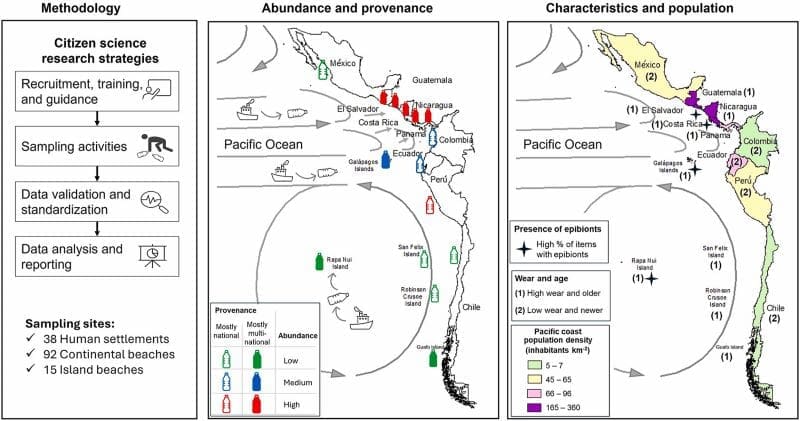
Bottles of local origin, but also Asian, European and North American
Regarding the origin of the bottles, the majority of those analysed with an identifiable origin (59.2%) came from Pacific countries of Latin America. Smaller proportions came from Asia (1.8%), North America (0.3%) and Europe (0.04%). In 38.7% of cases, the origin could not be identified.
“On the mainland beaches of Mexico, Guatemala and the southern countries – Colombia, Ecuador, Peru and Chile – most of the bottles came from the same country. In contrast, in the Central American countries – El Salvador, Nicaragua, Costa Rica and Panama – the percentages of locally sourced items were significantly lower, with those of external origin predominating,” the authors note.
On the island beaches, 42.4% of the bottles came from Latin American countries, but also had the highest percentage of items of Asian origin, and smaller proportions of European and North American origin. Panama showed the greatest diversity of origins, with items from at least six Latin American, Asian and North American countries. The island beaches of Rapa Nui and the Galápagos had very low percentages of locally sourced bottles and high proportions of products from Asia.
“The distribution of bottle origins is not random, but geographically structured, with a predominance of specific countries of origin in specific environments and sub-regions, and also in specific countries, of course,” the authors say. “This trend would reflect the consumption habits, waste management practices (where they exist) and oceanographic transport processes that influence the distribution of these plastic pollutants.”
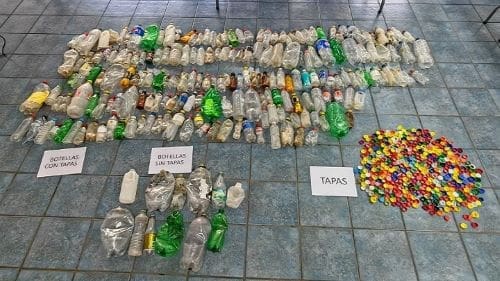
The study also identified the presence of epibionts – organisms that live on other living things or surfaces, such as those on plastic bottles and caps, and which are indicators of the exposure and residence times of objects in the marine environment – in 8.8% of the bottles found on beaches on average, a proportion that was higher on mainland beaches in Central American countries. This pattern reinforces the idea of plastic bottles and caps arriving at these sites via marine currents.
Towards greater individual, social and corporate responsibility
Raising public awareness about respect for the environment, promoting the use of reusable packaging and strengthening the corporate social responsibility of producers – together with international actions such as the UN Global Plastic Treaty – are essential strategies to reduce plastic pollution and protect coastal ecosystems. These actions could be replicated in other regions of the world to minimise the human footprint on natural environments and improve the healthiness of urban environments.
“In the future, we want to analyse the impact of seasonal climatic variations, river inputs and tourist activity on the dynamics of plastic bottle and cap pollution on coasts and in coastal cities. Oceanographic modelling could also be integrated to track the transport trajectories of plastic litter in the ocean and thus identify distant sources of pollution,” conclude Miquel Canals and Ostin Garcés-Ordóñez.
Journal Reference:
Garcés-Ordóñez, Ostin et al., ‘Abundance, provenance, and characteristics of plastic beverage bottles in human settlements and on beaches of the Latin American Pacific region: a citizen science study’, Journal of Cleaner Production 521, 146234 (2025). DOI: 10.1016/j.jclepro.2025.146234
Article Source:
Press Release/Material by University of Barcelona
Global plastic pollution treaty essential to tackle growing health risks to all life on earth
World-leading researchers and charities are calling on countries attending global plastic pollution treaty negotiations (INC-5.2) to agree legally-binding commitments, as a new report synthesizing the current state of knowledge highlights the growing risk to human, wildlife and environmental health.
WWF’s new report conducted in collaboration with the University of Birmingham, titled: Plastics, Health, and One Planet, synthesizes almost 200 pieces of the latest and most notable peer-reviewed research on the potential risks that plastic pollution – especially micro- and nanoplastics (MnP) and associated high-risk chemicals – poses to human and environmental health.
The new report is published ahead of governments from around the world meeting in Geneva for the final global plastic pollution treaty negotiations (INC-5.2). Professor Stefan Krause and the team from the Birmingham Plastics Network who produced the report with WWF show that MnP, as well as plastic additives, are associated with a range of biological effects. These include endocrine disruption and hormone-related cancers – such as breast and testicular cancer, reproductive and fertility impairments, and chronic respiratory conditions.
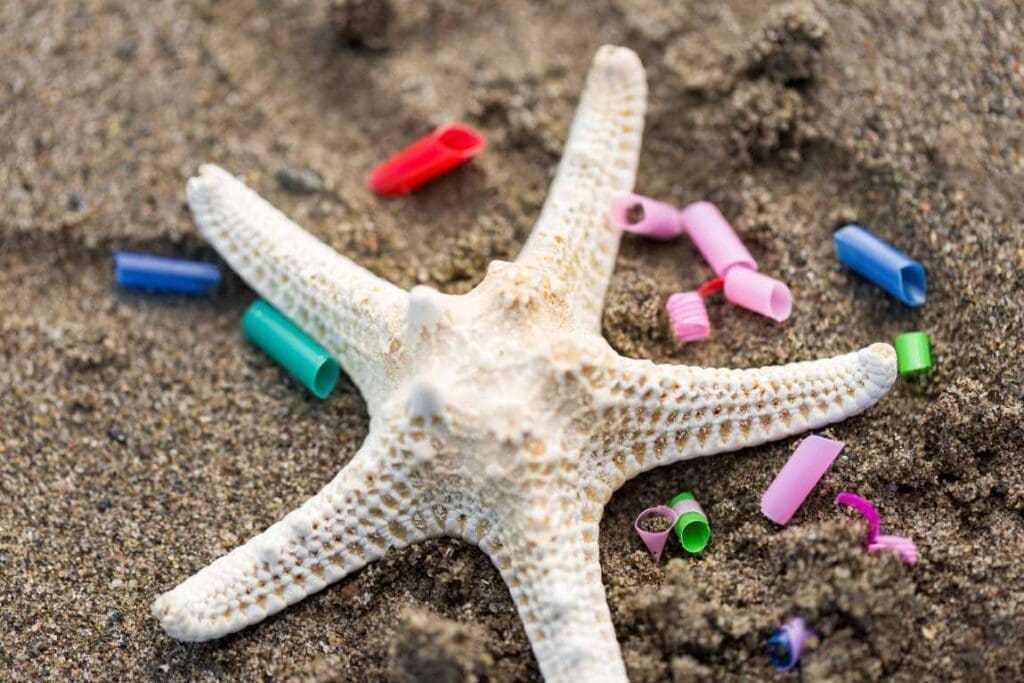
Professor Stefan Krause, University of Birmingham: “The precautionary principle has guided multiple international agreements with great success, notably the 1987 Montreal Protocol, when countries acted decisively on ozone-depleting substances before the science was fully settled, preventing millions of cases of skin cancer and facilitated the restoration of the ozone layer.”
While research continues to evolve, the report argues that current evidence sufficiently justifies why the precautionary principle – acting where credible risks are identified, even in the absence of absolute scientific certainty – must be invoked to minimise future harm.
Professor Stefan Krause, from the University of Birmingham, said: “The precautionary principle has guided multiple international agreements with great success, notably the 1987 Montreal Protocol, when countries acted decisively on ozone-depleting substances before the science was fully settled, preventing millions of cases of skin cancer and facilitated the restoration of the ozone layer.
“Building on this precedent, we urge governments and negotiators to deliver a science-based, legally binding treaty that not only tackles plastic pollution at its roots by including global bans and phase outs of the most harmful products and chemicals, but also makes protecting human, wildlife and environmental health a core function.”
The meeting of governments on August 4 comes after previous attempts to finalise a global plastic pollution treaty have failed to conclude by consensus while every day 30,000 tonnes of plastic finds its way into the world’s oceans.
WWF, supported by the evidence from the University of Birmingham’s Plastic Network are calling for negotiations in Geneva to conclude with a treaty built on specific binding rules supported by most countries to be able to effectively tackle global plastic pollution. This must include:
- global bans on the most harmful plastic products and chemicals;
- global product design requirements to enable a non-toxic circular economy;
- financial and technical support for developing countries to ensure effective implementation and;
- mechanisms to strengthen and adapt the treaty over time.
Zaynab Sadan, Global Plastics Policy Lead, WWF said: “In a world of shifting politics, these negotiations are on a knife edge. The ambitious majority must now forge their own path to a meaningful treaty through voting or forming a majority coalition. By rejecting bad-faith obstruction and leveraging their strength in numbers, the ambitious majority can build a treaty that helps protect people now and for generations to come. They have the support and they have the tools. Now they need to deliver.”
Article Source:
Press Release/Material by University of Birmingham
Featured image credit: Gerd Altmann | Pixabay



